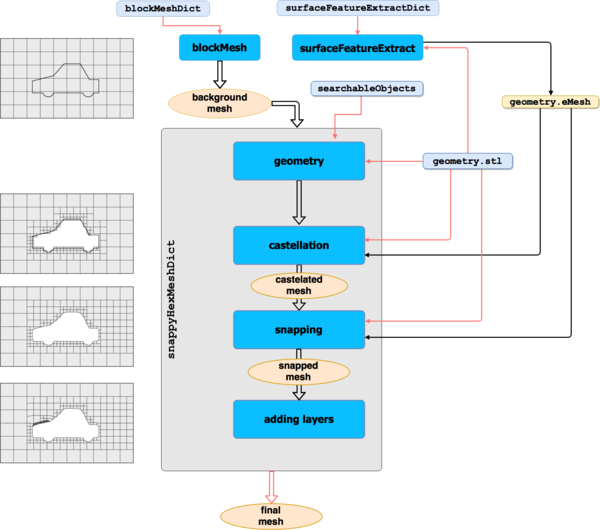Overview🔗
snappyHexMesh is a fully parallel, split hex, mesh generator that
guarantees a minimum mesh quality. Controlled using OpenFOAM
dictionaries, it is particularly well suited to batch driven operation.
Key features:
- starts from any pure hex mesh (structured or unstructured)
- reads geometry in triangulated formats, e.g. in
stl,obj,vtk - no limit on the number of input surfaces
- can use simple analytically-defined geometry, e.g. box, sphere, cone
- generates prismatic layers
- scales well when meshing in parallel
- can work with dirty surfaces, i.e. non-watertight surfaces
Meshing process🔗
The overall meshing process is summarised by the figure below:

This includes:
- creation of the background mesh using the blockMesh utility (or any other hexahedral mesh generator)
- extraction of features on the surfaces with
surfaceFeatureExtractutility - setting up the
snappyHexMeshDictinput dictionary - running
snappyHexMeshin serial or parallel
Evolution of the snappy mesh for the iglooWithFridges tutorial is shown below:
Configuration🔗
Meshing controls are set in the snappyHexMeshDict located in the case
system directory. This has five main sections, described by the following:
- Geometry: specification of the input surfaces
- Castellation: starting from any pure hex mesh, refine and optionally load balance when running in parallel. The refinement is specified both according to surfaces, volumes and gaps
- Snapping: guaranteed mesh quality whilst morphing to geometric surfaces and features
- Layers: prismatic layers are inserted by shrinking an existing mesh and creating an infill, subject to the same mesh quality constraints
- Mesh quality: mesh quality settings enforced during the snapping and layer addition phases
- Global
Usage🔗
The command snappyHexMesh executes the meshing process. Adding the -help
option, i.e.
snappyHexMesh -help
returns the list of available options:
Usage: snappyHexMesh [OPTIONS]
Options:
-case <dir> Case directory (instead of current directory)
-checkGeometry Check all surface geometry for quality
-decomposeParDict <file>
Alternative decomposePar dictionary file
-dict <file> Alternative snappyHexMeshDict
-dry-run Check case set-up only using a single time step
-outFile <file> Name of the file to save the simplified surface to
-overwrite Overwrite existing mesh/results files
-parallel Run in parallel
-patches <(patch0 .. patchN)>
Only triangulate selected patches (wildcards supported)
-profiling Activate application-level profiling
-region <name> Specify alternative mesh region
-surfaceSimplify <boundBox>
Simplify the surface using snappyHexMesh starting from a
boundBox
-doc Display documentation in browser
-help Display short help and exit
-help-compat Display compatibility options and exit
-help-full Display full help and exit
Automatic split hex mesher. Refines and snaps to surface
Using: OpenFOAM-2306 (2306) - visit www.openfoam.com
Build: _fbf00d6b-20230626
Arch: LSB;label=32;scalar=64
By default, each of snappyHexMesh’s phases, i.e castellation, snapping and
layer addition will write a complete mesh in time folders. This behaviour can
be suppressed by using the option
snappyHexMesh `-overwrite`
